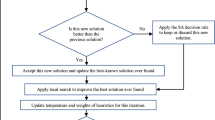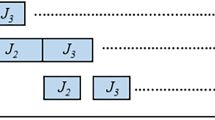Abstract
We consider large volume job shop scheduling problems, in which there is a fixed number of machines, a bounded number of activities per job, and a large number of jobs. In large volume job shops it makes sense to solve a fluid problem and to schedule the jobs in such a way as to track the fluid solution. There have been several papers which used this idea to propose approximate solutions which are asymptotically optimal as the volume increases. We survey some of these results here. In most of these papers it is assumed that the problem consists of many identical copies of a fixed set of jobs. Our contribution in this paper is to extend the results to the far more general situation in which the many jobs are all different. We propose a very simple heuristic which can schedule such problems. We discuss asymptotic optimality of this heuristic, under a wide range of previously unexplored situations. We provide a software package to explore the performance of our policy, and present extensive computational evidence for its effectiveness.
Similar content being viewed by others
References
Adams, J., Balas, E., & Zawack, D. (1988). The shifting bottleneck procedure for job shop scheduling. Management Science, 34, 391–401.
Balas, E. (1968). Machine sequencing via disjunctive graphs: an implicit enumeration algorithm. Operations Research, 17, 941–957.
Barany, I. (1981). A vector sum theorem and its application to improving flow shop guarantees. Mathematics of Operations Research, 6, 445–452.
Bertsimas, D., & Gamarnik, D. (1999). Asymptotically optimal algorithms for job shop scheduling and packet routing. Journal of Algorithms, 33, 296–318.
Bertsimas, D., & Sethuraman, J. (2002). From fluid relaxations to practical algorithms for job shop scheduling: the makespan objective. Mathematical Programming, 1, 61–102.
Bertsimas, D., Gamarnik, D., & Sethuraman, J. (2003). From fluid relaxations to practical algorithms for job shop scheduling: the holding cost objective. Operations Research, 51(5), 798–813.
Boudoukh, T., Penn, M., & Weiss, G. (1998). Job-shop—an application of fluid approximation. In I. Gilad (Ed.), Proceedings of the tenth conference of industrial engineering and management, pp. 254–258. June 1998, Haifa Israel.
Boudoukh, T., Penn, M., & Weiss, G. (2001). Scheduling job shops with some identical or similar jobs. Journal of Scheduling, 4, 177–199.
Carlier, J., & Pinson, E. (1989). An algorithm for solving the job-shop problem. Management Science, 35(2), 164–176.
Chen, H., & Yao, D. D. (2003). Fundamentals of queuing networks, performance, asymptotics and optimization. New York: Springer.
Chen, M., Pandit, C., & Meyn, S. (2003). In search of sensitivity in network optimization. Queuing Systems Theory and Applications, 44, 313–363.
Conway, R. W., Maxwell, W. L., & Miller, L. W. (1967). Theory of scheduling. Reading: Addison-Wesley.
Dai, J. G., & Lin, W. (2005). Maximum pressure policies in stochastic processing networks. Operations Research, 53, 197–218.
Dai, J. G., & Lin, W. (2006, submitted). Asymptotic optimality of maximum pressure policies in stochastic processing networks. Annals of Applied Probability.
Dai, J. B., & Weiss, G. (2002). A fluid heuristic for minimizing makespan in job-shops. Operations Research, 50, 692–707.
Demers, A., Keshav, S., & Shenker, S. (1990). Analysis and simulation of a fair queuing algorithm. Internetworking Research and Experience, 1.
Gantt, H. L. (1910) Work, wages and profit. The Engineering Magazine, New York, 1910; republished as Work, wages and profits, Easton, Pennsylvania, Hive Publishing Company, 1974, ISBN 879600489.
Garey, M. R., & Johnson, D. S. (1979). Computers and intractability: a guide to the theory of NP-completeness. San Francisco: Freeman.
Gittins, J. C. (1979). Bandit processes and dynamic allocation indices. J Royal Statistical Society Series B, 14, 148–167.
Goldratt, E. M., & Cox, J. (1987). The goal: excellence in manufacturing. Croton-on-Hudson: North River Press.
Greenberg, A. G., & Madras, N. (1992). How fair is fair queuing? Journal of the Association for Computing Machinery, 39, 568–598.
Hanen, C. (1994). Study of a NP-hard cyclic scheduling problem: the recurrent job-shop. European Journal of Operational Research, 72, 82–101.
Harrison, J. M. (1988). Brownian models of queuing networks with heterogeneous customer populations. In W. Fleming, & P. L. Lions (Eds.), Proceedings of the IMA workshop on stochastic differential systems. New York: Springer.
Harrison, J. M., & Van Mieghem, J. (1997). Dynamic control of Brownian networks: state space collapse and equivalent workload formulations. Annals of Applied Probability, 7, 747–771.
Henderson, S. G., Meyn, S. P., & Tadic, V. B. (2003). Performance evaluation and policy selection in multiclass networks. Discrete Event Dynamic Systems, 13(1–2), 149–189.
Hochbaum, D. S., & Shamir, R. (1991). Strongly polynomial algorithms for high multiplicity scheduling problem. Operations Research, 39, 648–653.
Jansen, K., Solis-Oba, R., & Srividenko, M. (2000). Makespan minimization in job shops, a linear time approximation scheme. Preprint, see also preliminary versions in STOC’99 and APPROX’99.
Klimov, G. P. (1974). Time sharing service systems I. Theory of Probability and Applications, 19, 532–551.
Kopzon, A., Nazarathy, Y., & Weiss, G. (2008). A push pull system with infinite supply of work. Preprint.
Kulak, O., Yilmaz, I. O., & Gŭnther, H. O. (2007). PCB assembly scheduling for collect-and-place machines using genetic algorithms. International Journal of Production Research, 45(17), 3949–3969.
Kushner, H. J. (2001). Heavy traffic analysis of controlled queuing and communication networks. Berlin: Springer.
Kushner, H. J., & Martins, L. F. (1990). Routing and singular control for queuing networks in heavy traffic. SIAM Journal on Control and Optimization, 28, 1209–1233.
Kushner, H. J., & Ramachandran, K. M. (1989). Optimal and approximately optimal control policies for queues in heavy traffic. SIAM Journal on Control and Optimization, 27, 1293–1318.
Lawler, E. L., Lenstra, J. K., Rinnoy Kan, A. H. G., & Shmoys, D. B. (1993). In S. C. Graves, A. H. G. Rinnoy Kan, & P. H. Zipkin (Eds.), Sequencing and scheduling: algorithms and complexity, in logistics of production and inventory. New York: Elsevier Science.
Martin, P., & Shmoys, D. B. (1996). A new approach to computing optimal schedules for the job-shop scheduling problem. In International IPCO conference (pp. 389–403).
Matsuo, H. (1990). Cyclic sequencing problems in the two-machine permutation flow shop: complexity, worst-case and average-case analysis. Naval Research Logistics, 37, 679–694.
McCormick, S. T., Pinedo, M. L., Shenker, S., & Wolf, B. (1989). Sequencing in an assembly line with blocking to minimize cycle time. Operations Research, 37, 925–935.
Meyn, S. P. (2001). Sequencing and routing in multiclass queuing networks, part I: feedback regulation. SIAM Journal on Control and Optimization, 40, 741–776. IEEE International Symposium on Information Theory, Sorrento, Italy, June 25–June 30, 2000.
Meyn, S. P. (2008). Control techniques for complex networks. Cambridge: Cambridge University Press.
Moallemi, C. C., Kumar, S., & Van Roy, B. (2008). Approximate and data-driven dynamic programming for queuing networks.
Muth, J. F., & Thompson, G. L. (1954). Industrial scheduling. Prentice-Hall: Englewood Cliffs.
Nazarathy, Y. (2001). Evaluation of on line scheduling rules for high volume job shop problems: a simulation study. MA thesis, The University of Haifa, Israel.
Nazarathy, Y., & Weiss, G. (2008). Positive Harris recurrence and diffusion scale analysis of a push pull queuing network. Preprint.
Nazarathy, Y., & Weiss, G. (2009). Near optimal control of queuing networks over a finite time horizon. Annals of Operations Research, 170, 233–249.
Ni-o-Mora, J. (2001). Restless bandits, partial conservation laws and indexability. Advances in Applied Probability, 33, 76–98.
Ni-o-Mora, J. (2002). Dynamic allocation indices for restless projects and queuing admission control: a polyhedral approach. Mathematical Programming, Series A, 93, 361–413.
Ni-o-Mora, J. (2006). Restless bandit marginal productivity indices, diminishing returns and optimal control of make-to-order/make-to-stock M/G/1 queues. Mathematics of Operations Research, 31, 50–84.
Papadimitriou, C. H., & Tsitsiklis, J. N. (1999). The complexity of optimal queuing network control. Mathematics of Operations Research, 24(2), 293–305.
Parekh, A. K., & Gallager, R. G. (1993). A generalized processor sharing approach to flow control in integrated services networks: the single-node case. IEEE/ACM Transactions on Networking, 1, 344–357.
Parekh, A. K., & Gallager, R. G. (1994). A generalized processor sharing approach to flow control in integrated services networks: the multiple-node case. IEEE/ACM Transactions on Networking, 2, 137–150.
Pinedo, M. (2002). Scheduling, theory, algorithms and systems (3rd edn.). New York: Springer.
Roundy, R. (1992). Cyclic scheduling for job shops with identical jobs. Mathematics of Operations Research, 17, 842–865.
Sevastyanov, S. V. (1987). Bounding algorithm for the routing problem with arbitrary paths and alternative servers. Cybernetics, 22, 773–781.
Sevastyanov, S. V. (1994). On some geometric methods in scheduling theory, a survey. Discrete Applied Mathematics, 55, 59–82.
Sevastyanov, S. V., & Woeginger, G. J. (1998). Makespan minimization in open shops, a polynomial type approximation scheme. Mathematical Programming, 82, 191–198.
Shmoys, D. B., Stein, C., & Wein, J. (1994). Improved approximation algorithms for shop scheduling problems. SIAM Journal on Computing, 23, 617–632.
Stallings, W. (2007). Data and computer communications (8th edn.). Upper Saddle River: Prentice-Hall.
Stolyar, A. L. (2004). MaxWeight scheduling in a generalized switch: state space collapse and equivalent workload minimization under complete resource pooling. Annals of Probability, 14, 1–53.
Storer, R. H., Wu, S. D., & Vaccari, R. (1992). New search spaces for sequencing problems with application to job shop scheduling. Management Science, 38, 1495–1509.
Tassiulas, L. (1995). Adaptive back-pressure congestion control based on local information. IEEE Transactions on Automatic Control, 40, 236–250.
Van Zant, P. (2004). Microchip fabrication (5th edn.). New York: McGraw-Hill.
Veatch, M. H. (2005). Approximate dynamic programming for networks: fluid models and constraint reduction. Preprint.
Wein, L. M. (1992). Scheduling networks of queues: heavy traffic analysis of a multistation network with controllable inputs. Operations Research, 40, S312–S334.
Weiss, G. (1995). On the optimal draining of a fluid re-entrant line. In F. P. Kelly, & R. Williams (Eds.), IMA volumes in mathematics and its applications : Vol. 71. Stochastic networks, proceedings of ima workshop, Minnesota, February 1994 (pp. 91–104). New York: Springer.
Weiss, G. (1999). Scheduling and control of manufacturing systems—a fluid approach. In Proceedings of the 37th allerton conference, (pp. 577–586), Monticello, IL, 21–24 September 1999.
Weiss, G. (2005). Jackson networks with unlimited supply of work and full utilization. Journal of Applied Probability, 42, 879–882.
Whittle, P. (1981). Restless bandits: activity allocation in a changing world. Journal of Applied Probability 25A, 287–298.
Williamson, D. P., Hall, L. A., Hoogeveen, J. A., Hurkens, C. A. J., Lenstra, J. K., Sevast’ynaov, S. V., & Shmoys, D. B. (1997). Short shop schedules. Operations Research, 45, 288–294.
Zhang, H. (1995). Service disciplines for guaranteed performance service in packet-switching networks. In Proceedings of the IEEE, October 1995.
Author information
Authors and Affiliations
Corresponding author
Additional information
Research supported in part by Israel Science Foundation Grant 249/02 and 454/05 and by European Network of Excellence Euro-NGI.
Part of this research was conducted while Yoni Nazarathy was a student at the University of Haifa.
Rights and permissions
About this article
Cite this article
Nazarathy, Y., Weiss, G. A fluid approach to large volume job shop scheduling. J Sched 13, 509–529 (2010). https://doi.org/10.1007/s10951-010-0174-0
Published:
Issue Date:
DOI: https://doi.org/10.1007/s10951-010-0174-0




